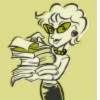 Mora, Pat. Francisco X. Mora. (Ill.) 1998. DELICIOUS HULLABALOO=PACHANGA DELICIOSA. Houston, TX: Piñata Books. ISBN 1-55885-246-8
Mora, Pat. Francisco X. Mora. (Ill.) 1998. DELICIOUS HULLABALOO=PACHANGA DELICIOSA. Houston, TX: Piñata Books. ISBN 1-55885-246-8PLOT SUMMARY
DELICIOUS HULLABALOO=PACHANGA DELICIOSA by Pat Mora is a poem picture book packed with color and sound. A collection of brightly colored animals converge upon a desert home. Lizards, armadillos and birds all have a role to play in preparing for their get together. Young readers will see a salsa-mixing armadillo and guitar-picking lizards as they watch the party unfold. This poem is presented in a bilingual format with the English and Spanish verses on the same page.
CRITICAL ANALYSIS (INCLUDING CULTURAL MARKERS)
While the text in this poem picture book is a bit esoteric, the illustrations will please younger readers. Interlingualism, literary tools, and illustration are utilized to portray the lively preparation for a desert celebration in DELICIOUS HULLABALOO.
Mora uses interlingualism, switching back and forth from English to Spanish, in DELICIOUS HULLABALOO. This use of Spanish terms in the English version comes across as a natural melding of the two languages. Unfortunately, interlingualism is used only in the English translation of the poem. The exclusion of English terms in the Spanish translation is a missed opportunity to encourage bilingualism.
Rhyme, onomatopoeia, and alliteration are used to attempt a lyrical feel in this poem. Rhyme is used consistently in the English translation. Since rhyme is not a commonly used tool in Spanish, it is predictable that the use of rhyme in PACHANGA DELICIOSA is sporadic. Onomatopoeic terms such as “umm” and “buzz” allow the reader to hear and experience the poem simultaneously. Mora’s biggest success in this book is her use of alliteration. “La sabrosa salsa salpica” and “the sassy salsa splashing” is an exemplary use of bilingual alliteration and translation.
Fransisco Mora’s illustrations convey the influence of the southwestern United States. Bright colors and zig-zag patterns adorn everything in this book—from the armadillos to the fruits in the bowl. These oversimplified illustrations are not likely to be appealing to older children.
The use of interlingual text and alliteration are this poem picture book’s biggest assets. Some verses of the poem, however, may leave the reader wondering in which language the poem was first written. The inconsistency in quality among verses in both English and Spanish—presumably a translation problem—is both surprising and disappointing considering Pat Mora’s reputation as a children’s author.
REVIEW EXCERPTS
“The somewhat stilted poem, presented in both English and Spanish, rhymes in both languages. The simple geometric patterns and warm colors of the illustrations help convey the southwestern setting.” (Horn Book)
“Many of the half-rhymed and rhymed couplets sound forced in English. The narrative reads slightly more smoothly in Spanish, but the poetry and story are unremarkable. The accompanying cartoon drawings are equally unimpressive….” (School Library Journal)
Reviews obtained from Follett Library Resources and accessed at:
http://www.flr.follett.com/search?SID=647f178bfe2a50a6782ecbc9a0d981bf
CONNECTIONS
Other of poetry for children K-6:
Thompson, Richard. THE FOLLOWER, ISBN 978-1-55041-880-4
Mora, Pat (Ed.) LOVE TO MAMA, ISBN 978-1-58430-235-3
Ada, Alma Flor. DREAMING FISH, ISBN 978-1-58105-581-8
Other books by Pat Mora:
UNO, DOS, TRES: ONE, TWO, THREE, ISBN 978-0618054688
TOMAS AND THE LIBRARY LADY, ISBN 978-0375803499
THE RAINBOW TULIP, ISBN 978-0670872916


